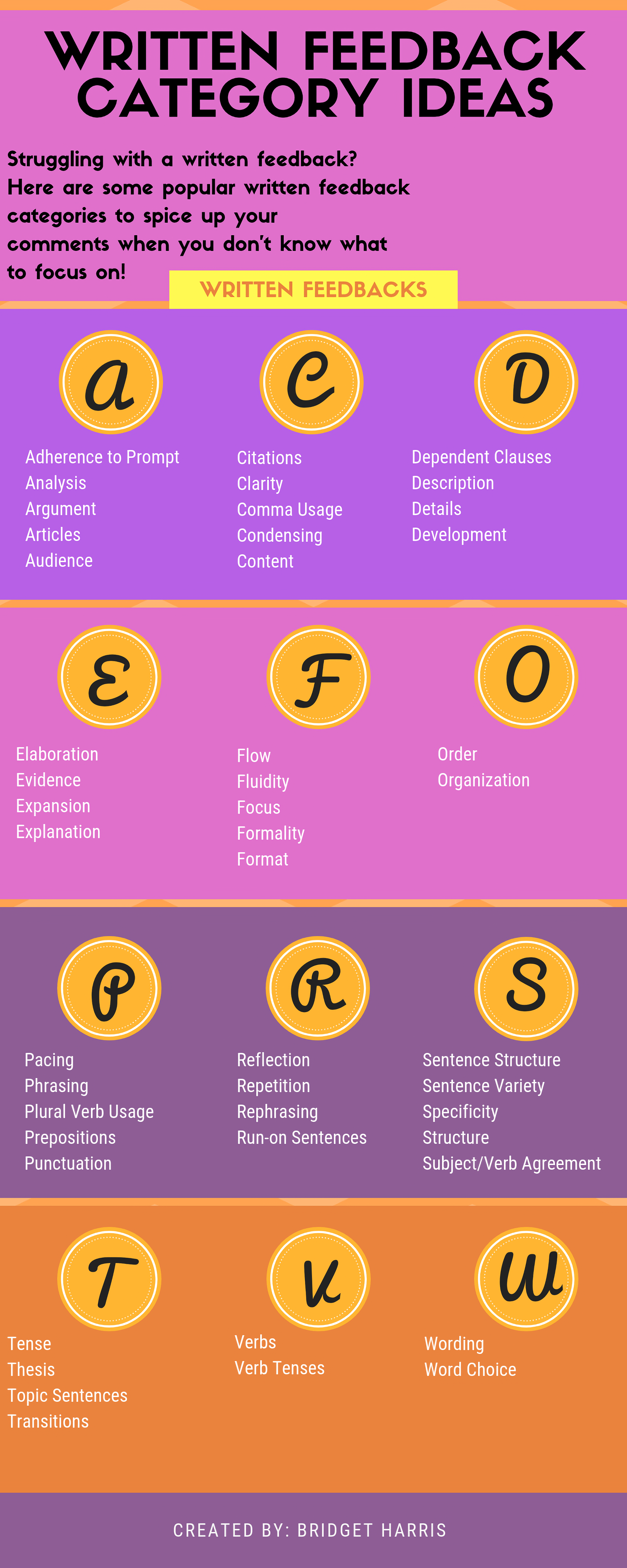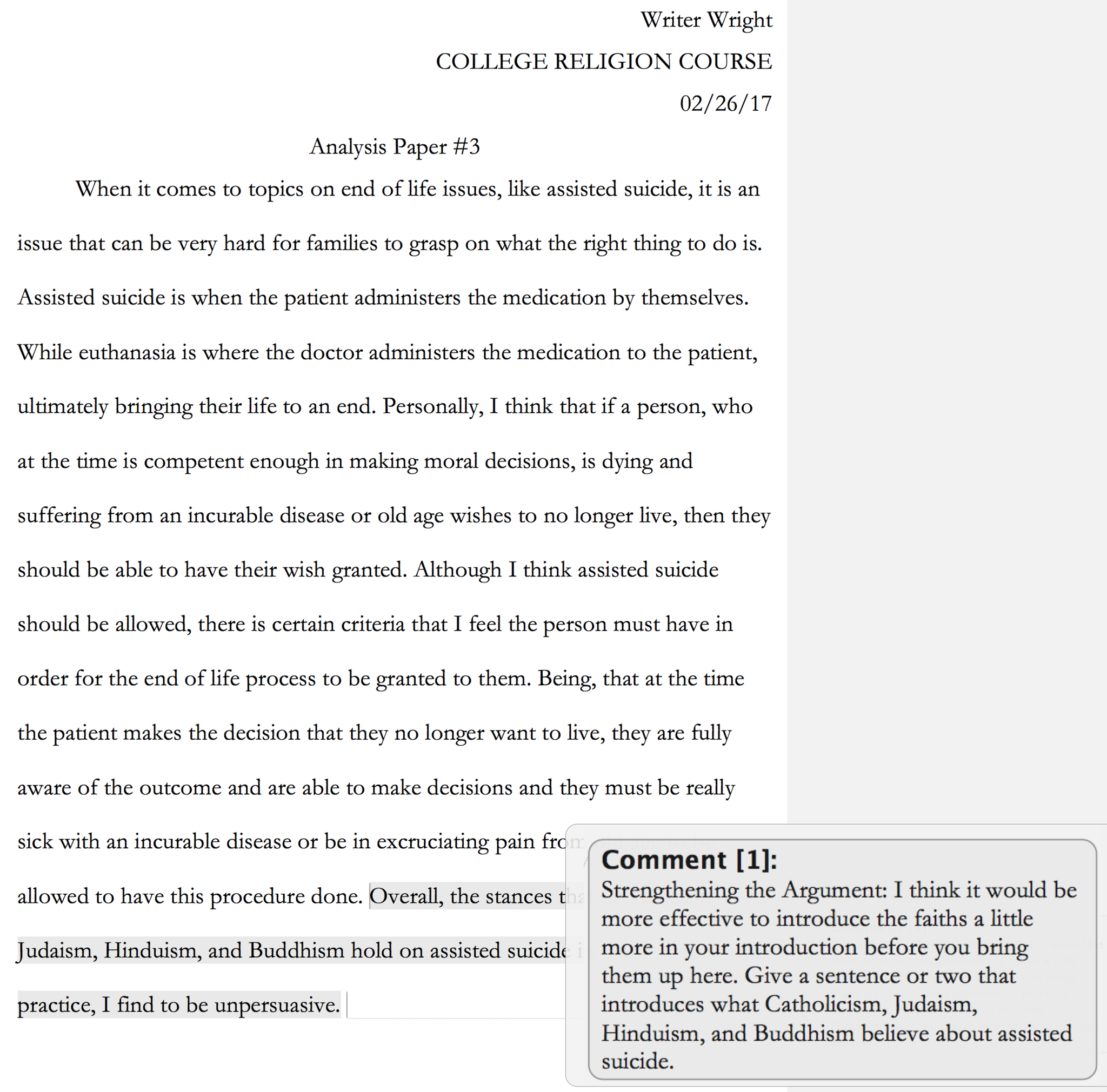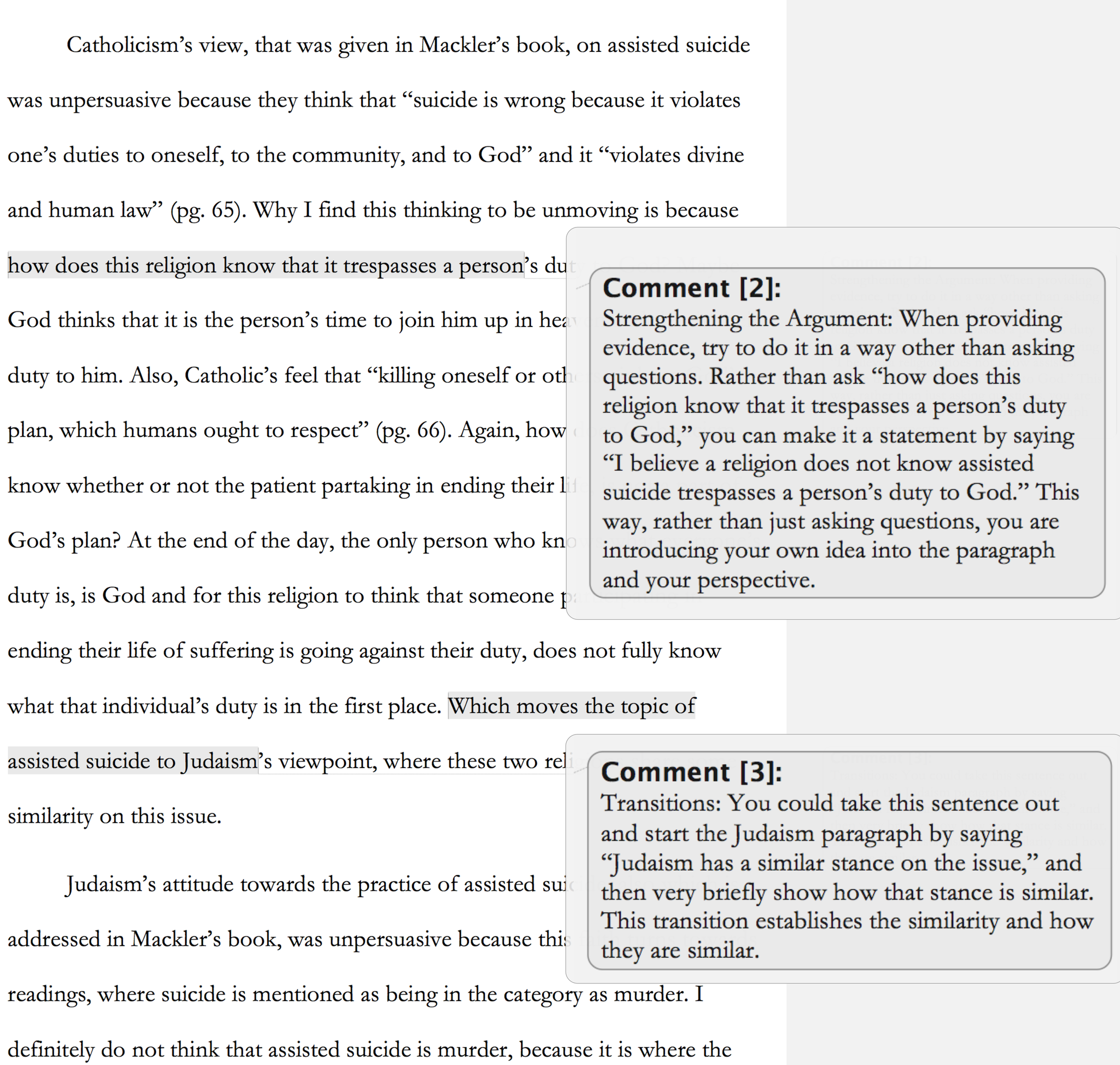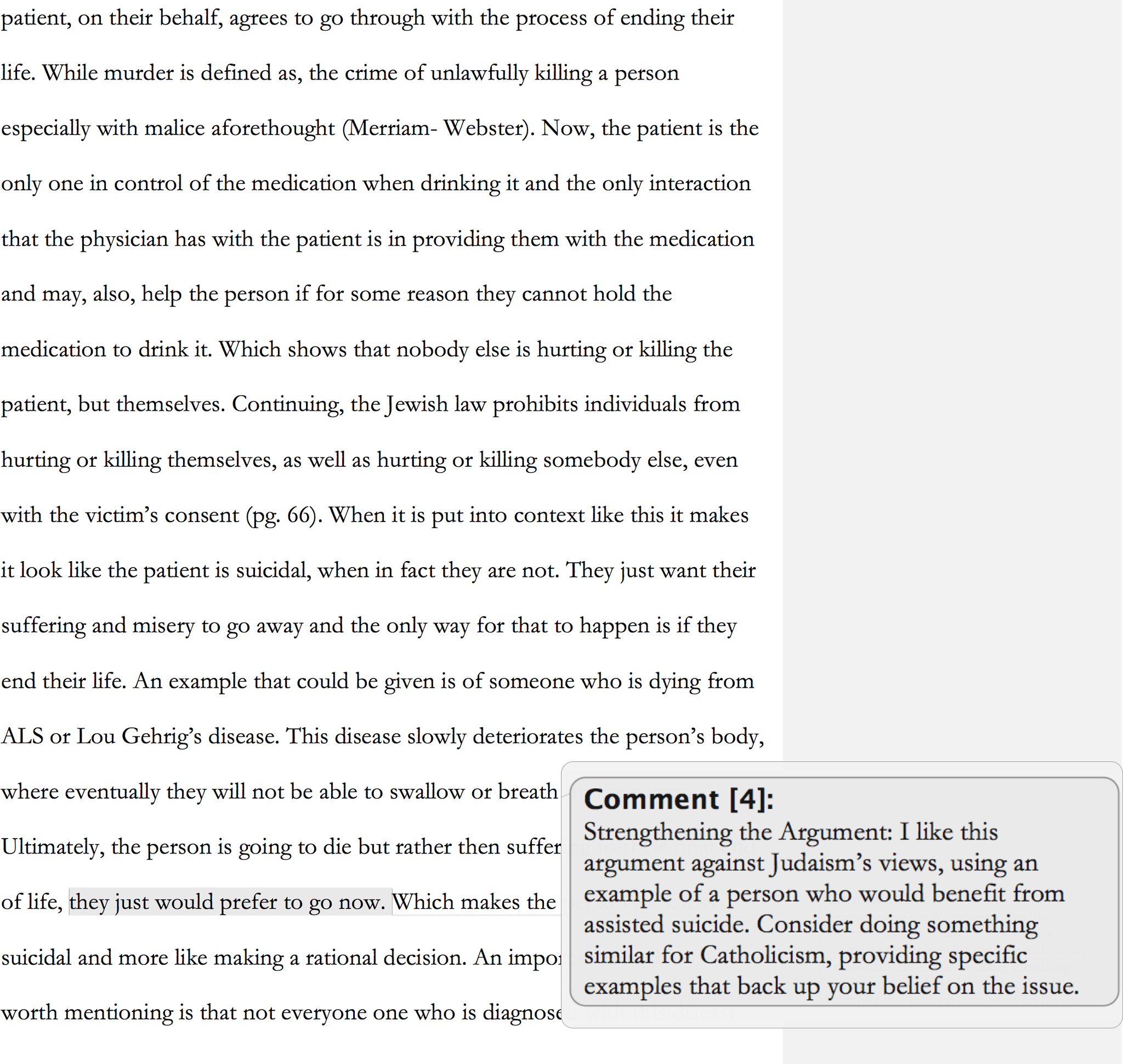In written feedback appointments,  Writing Center Tutors carefully read a digital copy of a draft a writer uploads and then provide feedback on that draft. Your goal as the tutor is to provide thoughtful commentary about how the writer’s text connects with you, an authentic reader, and suggest next steps the writer might take to revise their draft.
Writing Center Tutors carefully read a digital copy of a draft a writer uploads and then provide feedback on that draft. Your goal as the tutor is to provide thoughtful commentary about how the writer’s text connects with you, an authentic reader, and suggest next steps the writer might take to revise their draft.
🗺️ Appointment Overview
You provide “formative feedback”—feedback that is non-evaluative, supportive, specific, credible, and genuine (Schwartz & White, 2000). Your feedback gives the writer a sense of what aspects of their work you find clear and rhetorically effective and what aspects of their work you find confusing, problematic, or might otherwise benefit from revision.
You “dramatize the presence of the reader” (Sommers, 1982, p. 148) to provide the writer with a detailed, explicit articulation of what you, as a reader, experience when you read the writer’s writing. Your goal in each written feedback appointment is to provide the writer with your sense of what they might consider keeping as-is and what they might revise to build on and improve their work.
You provide written feedback in two primary ways:
- Providing marginal comments on particular parts of the writer’s draft
- Writing a summary letter
Never use the Track Changes feature in Microsoft Word or Google Docs. Track Changes appropriates the writer’s text and is often messy and hard to read.
So that the written feedback you offer to a writer is focused and actionable, in every written feedback appointment at the Writing Center
- Provide feedback on the writer’s entire draft and/or up to
- 8 pages in 60 minutes
- 12 pages in 90 minutes
- 16 pages in 120 minutes
- Write an
Appointment Letters to the writer and insert it at the beginning of the draft
- Make sure your appointment letter addresses all five components of written feedback appointments: rapport, exigence, agenda, methods, and next steps
- Limit your agenda to 1, 2, or 3 foci—so as to make it realistic for you to provide feedback in the allotted appointment time and to avoid overwhelming the writer with too much at once
- Collaboratively set an agenda with the writer (though they are not present during the appointment) based on any requests they make on their appointment form, and your sense of priority after reading their draft
- Label marginal comments you make so that it’s clear which agenda item (of the 1, 2, or 3 agenda foci you collaboratively set with the writer) each marginal comment addresses
📚 Technical Step-by-Step
- Download the document from the appointment booking in WCOnline
- Do the appointment 😃
- Name the document using the Written Feedback naming conventions
- Copy-paste your appointment letter into the appointment report form in WCOnline
DO NOT click send to client, or enter a third-party email
DO click save!
- Upload the document into the Notion “Tutor View” for your specific appointment
- In the Reception Table, visit the “How to Use!” toggle to see some more tips
- Once uploaded, click the checkbox for “WF Uploaded?” to automatically send a message in a designated Slack channel for the
Receptionist
- Check the “Third-Party Email” column and update that if the receptionist missed anything to ensure the information is sent in all the correct areas
⏰ Time Allocation
How to Allot Your Time Effectively
- Read through the writer’s entire document, keeping in mind the writer’s exigence and any specific feedback requests they make on their appointment form.
- As you read the draft initially, hold off on writing any comments while you create a plan, set priorities for your feedback and suggestions, and strategize how you will respond.
- Reading the draft through without commenting gives you a chance to process the draft as a whole and will ultimately allow you to be more efficient and strategic in your commenting. For example, if you dive in and start talking about the need for a thesis only to realize that the writer has a well-developed thesis in their conclusion, then you will have to spend extra time revising your initial comments.
- You may, however, find it useful to insert blank comments in certain places in the draft while you read—places where you are likely to return to after reading the draft and definitively setting the appointment’s 1, 2, or 3 agenda foci. Should you adopt this strategy, make sure you are disciplined about not writing actual marginal comments, lest you end up inefficiently or ineffectively making the most of your appointment time.
- If the writer asks you to focus on a specific page range within a draft, scan the pages before and after the requested section to get a sense of how that section fits into the larger context.
General Guidelines
Appointment Length | 60m | 90m | 120m |
Reading the draft without commenting | 15 min | 17 min | 22 min |
Prioritizing feedback & setting the 1, 2, or 3-item agenda | 5 min | 5 min | 5 min |
Commenting on agenda items in marginal comments & summary letter | 25 min | 53 min | 78 min |
Labeling comments; reading through & revising feedback | 10 min | 10 min | 10 min |
Uploading the appointment letter | 3 min | 3 min | 3 min |
📛 Naming Conventions
Naming the Document
When you are uploading your written feedback to make it accessible for the receptionist, it is important to use the Writing Center written feedback naming convention for the document. Naming conventions must remain consistent so that the documents can be easily accessed in the archives. Many writers will visit the Writing Center multiple times, and therefore, each file needs to be distinguishable from the others.
Name your written feedback draft using CamelCase to group together like pieces of information (e.g., the writer’s LastNameAndFirstName) and underscores to separate each part of the file name.
Examples
Working in the Offices

Working remotely

🗂️ Appointment Guidelines
So that our work is consistent across all tutors, we ask that you always place appointment letters at the beginning of the draft, use 1 to 3 agenda items, and connect the summary letter to marginal comments.
Insert your appointment letter to the writer at the beginning of the draft. Doing so allows writers to easily see your appointment letter upon receiving their draft with your feedback, and gives your marginal comments more readily apparent meaning and utility as they read through them.
To allow you to make your appointment letter distinct from a writer’s draft, “insert page break” at the very beginning of the document and use the first page (or 2) to write your letter.
Use 1-3 Agenda Items
Limiting the agenda items of a written feedback appointment to 1, 2, or 3 foci both
- makes it realistic for you to provide feedback in the allotted appointment time
- avoids overwhelming the writer with too much information at once


Label Your Marginal Comments with Your Agenda Items
Labeling marginal comments benefits both the writer and you. By specifically noting which aspect of your agenda a marginal comment relates to, writers can make connections between the feedback in the summary (appointment) letter, the feedback that you provide in a particular comment, and the feedback you provide in other related marginal comments.
Labeling marginal comments helps prioritize what to focus on in your agenda. It is also an effective self-check to make sure you are sticking to your agenda, are not spreading your time too thin, and are not addressing too many aspects within the draft. By creating clear and cohesive feedback on 1, 2, or 3 agenda items, you give writers an in-depth examination of their work with multiple examples and suggestions for revision.
When you add marginal comments, label each one based on which aspect of the agenda it addresses. For example, if the agenda you set in the summary letter addresses argument and clarity, all marginal comments should be labeled either “argument” or “clarity.”
Use the same nomenclature that you use in the agenda to label each comment. For example, if you describe an agenda item as “making your paper clearer” in the appointment letter, don’t label comments that address that agenda item as “clarity.”
If you make a marginal comment and then, during the process of labeling your comments, find it difficult to connect the comment to any point of your agenda, this likely means it can be removed. If you feel the comment is too important to be removed, revise your agenda to accommodate it (making sure you have no more than 3 agenda points).
Don’t feel like you need several marginal comments per agenda point for it to be valid—some agenda points may be important but only require 1 marginal comment (e.g., thesis statement).
An exception to this is marginal comments that offer praise; if you want to offer a writer praise that does not directly relate to your agenda, you do not need to label it.
Connect Your Summary Letter to Your Marginal Comments
Your summary letter should address each label from your marginal comments in a clear and detailed section of the letter. Use this section of the summary letter to give the writer wholistic or broad information about this agenda item, perhaps a level of detail you did not include in any 1 particular marginal comment. Provide an explanation as to why this agenda item is important for revision and why revising it will help the writer successfully navigate their given exigence. Provide practical strategies for their revision plan.
🤗 Expectations
Provide Exemplary Feedback
Your comments should be tailored to the specific needs of the writer. The major goals of any appointment should be to support the writer’s agency and authority over their writing and position yourself as an ally to the writer in the writing process.
In addition to establishing rapport, exigence, agenda, methods, and next steps—exemplary written feedback
- maintains an encouraging tone and sense of deep and authentic engagement with the writer’s draft
- foregrounds the peer writing tutor’s experience as a reader
- contains both directive and non-directive feedback
- contains both positive and constructive comments
Prepare for Your Appointments
Before you begin providing feedback, familiarize yourself with any information the writer provided about their project and the kind of help or feedback they are seeking.
Check the appointment form to see if the writer has asked you to provide feedback on specific aspects of their project.
In cases where a writer sends a draft with more pages than you are expected to cover in the allotted appointment time, check if they have indicated which pages or sections they’d like you to focus on. If not, check their WCOnline account to see if they have received any recent feedback on the same draft or project; if they have, find the point in the draft at which the previous tutor stopped and start there, quickly scanning that part of the draft. Otherwise, start from the top and work through the appropriate number of pages for the appointment length.
Prepare yourself to focus for the whole appointment. You may find it effective to isolate yourself from potential distractions like nearby face-to-face appointments, group work, or friends you might wish to speak with by wearing headphones and listening to music or other audio that helps you focus, moving to an empty table, or relocating to another room.
🧪 Appointment Components
While in other modalities (face-to-face, online realtime), you write an appointment letter at the end of the appointment to document and enrich the collaborative work of the appointment, in written feedback appointments, your letter is 1 of 2 ways you engage with the writer and their work. As such, consider writing the letter throughout the appointment. If you find it better to write the letter after reading the entire draft and writing marginal comments, be thinking about the content you will include in your letter throughout the appointment time.
You will incorporate all 5 of the appointment components throughout your written feedback appointments, both in the summary letter and the marginal comments.
🫂 Rapport
Start your summary letter with a greeting. Introduce yourself to the writer and thank them for submitting their draft. If you have a personal connection to the subject matter or genre, that can also be a genuine and effective way to establish rapport.
Rapport Example in a Summary Letter
Hey Marcus, This is Owen O. coming at you from my couch in my living room. Thanks so much for submitting your draft today. Both my aunts are nurses, so I thought your paper about best practices in Nursing was super interesting!
In addition to the introductory remarks in the beginning of the summary letter, you should maintain a friendly and conversational tone throughout the appointment—both in your summary letter and in your marginal comments. This will help to build and develop rapport with the writer.
🙋 Exigence
Acknowledging the writer’s exigence for the project and for scheduling an appointment at the Writing Center is important in establishing solidarity between you and the writer. By acknowledging a writer’s request for specific feedback, restating any known information about the appointment, assignment guidelines, due date, etc., you let the writer know that you are listening to their concerns and are invested in their success with the project and as a writer.
Exigence Example in a Summary Letter
Thanks for sharing your draft of your cover letter and resume. It’s exciting that you’re nearing graduation and applying to jobs in your field! I understand that you’d like help with writing more professionally, so I made tone part of my focus for today’s appointment.
The content of your marginal comments should reinforce your understanding of and response to the writer’s concerns or questions. For example, you should give focused suggestions that are doable in the time the writer has before their deadline: “Considering you have a few days before your final draft is due and that you’re concerned about paraphrasing, you might consider reviewing the article you read and trying the paraphrasing activity I mentioned above.”
🗒️ Agenda
As you do in other appointment modalities, you should collaboratively set an agenda with the writer in a written feedback appointment. While the asynchronous nature of the written feedback appointment means that you can’t discuss and negotiate the agenda with the writer in real time, you should be transparent about what you focus on during the appointment and why (you can find more about how to know what to comment on in The Hierarchy of Concerns). An agenda not only helps you be transparent with a writer, but also helps you stay focused on specific concerns.
The agenda should be set and explained in the summary letter, then expanded on throughout the text by using marginal comments. In the summary letter, list the 1, 2, or 3 items you’re going to focus on, explain the importance of each item in detail, and provide an example from the text to demonstrate your points. In your marginal comments, label each comment with its corresponding agenda item, give text-specific feedback, then provide multiple suggestions for revision—when appropriate.
Agenda Example in a Summary Letter
As I read and commented, I focused on two main items: tone and specific language. Tone: An important thing to keep in mind about a cover letter is its purpose—to advertise yourself as the ideal candidate for the position. Part of this is making sure you come off as professional as possible. This means avoiding the use of colloquial (or informal) language. There were a few examples where your tone seemed to drift into a more informal or casual tone, such as when you used the phrase, “way back when.” As you revise, think about the language you would use in an interview setting where you wanted to come off as a professional—what kind of language would you use? Specific Language: Another key aspect of selling yourself as the “ideal candidate” is being as specific as possible. Remember, the hiring manager is looking for reasons that you are a good candidate, so give them as many specific reasons as possible! For example, when you say, “I believe I would be a very good fit,” it doesn’t tell the hiring manager why you’re a good fit. Get as specific as you can without losing conciseness—this means using specific examples from your past, naming specific skills you possess, and pointing out the specific parts of the job you feel you’d excel at and why.
Agenda Example in a Marginal Comment
Tone: Here’s an example of using language that might be a little too informal. Instead of saying, “I rock at speaking French,” here are a few other options you could consider that would elevate your language and keep your tone more formal: I have advanced proficiency in French, I am a native-level French speaker, or I am highly proficient in written and spoken French.
🛠️ Methods
In written feedback appointments, describing your methods differs somewhat from other appointment modalities. For example, in an online realtime appointment, your letter to the writer describes the methods you used in the appointment (e.g., “I suggested we try reverse outlining your draft. I started by identifying the first two items in the outline, then you identified the main points of the second and third paragraphs”). However, in written feedback appointments, the summary letter and marginal comments are your methods, so you should explain in your letter how the writer can utilize the feedback. In addition, the writing strategies and resources you suggest in your letter or marginal comments serve as methods the writer can try out on their own.
Methods Example in a Summary Letter
I made marginal comments throughout your draft with tips for how to revise specific parts of your cover letter. As you revise (and write future cover letters), here’s a useful resource to reference: https://theinterviewguys.com/how-to-write-a-cover-letter-examples-included/. I like this site because it provides examples and clear explanations.
Methods Example in a Marginal Comment
Commas: As identified above, I’ve noticed a pattern with missing commas following introductory words or phrases, and I hope you are seeing the trend based on my comments. In this sentence, can you identify where the comma should be placed? Consider using the explanations provided above, and check out this website for more examples and information: http://www.quickanddirtytips.com/education/grammar/what-is-a-subordinate-clause.
🏃 Next Steps
Suggesting next steps gives writers a concrete idea of how they can move forward in revising the specific draft you worked on in the appointment and how to apply your feedback to future projects. Our goal is to equip writers with strategies, techniques, and/or resources that they can use across many different forms of writing.
You might suggest that a writer read their draft aloud, find additional research to support their claims, schedule another appointment at the Writing Center for additional feedback, or any strategy that may help them continue in their writing process. In trying to explain a particular grammar convention, genre convention, or citation style in a memorable and impactful way; it may be helpful to include an online resource. Suggesting strategies to try or resources to check out can be done in either the summary letter or a marginal comment.
Next Steps Example in a Summary Letter
Try circling or highlighting all the instances in your draft where you reference an author’s name or include an in-text citation. Then cross reference your highlights with your Works Cited page to ensure you’ve included all of your sources in both your document and Works Cited. If you’re interested in learning more about MLA in-text citations, you should definitely check out this resource on the Purdue Owl website: https://owl.english.purdue.edu. I use it all the time in my own writing!
📜 Sample Written Feedback
Appointment Letter
Hi, [Name of Writer]!
Thank you for sending your draft in to the Writing Center today! I’m Riley and I read over your paper this afternoon.
I saw in your appointment form that you wanted me to look at transitions, and I made this a priority in my feedback. I also focused on how I think you can strengthen your argument. I left marginal comments in your draft with specific feedback about places you might revise your paper to address strengthening your argument and transitions.
Here are some bigger-picture ideas about those two agenda items and potential next steps you can take in your revision:
- Strengthening the Argument: In a couple of places, you support your stance by asking questions of the religion. As a reader, I didn’t find this to be very compelling, and it didn’t prove your stance on the subject. My advice would be to take those questions and turn them into statements. Rather than asking “how does this religion know this?” you can say “the religion does not know this.” This is a bit more effective and powerful, and gives the reader a better idea of your stance. I also like how you use the example of someone with ALS as a way to refute Judaism’s stance, and I think this strategy might be effective in your other paragraphs as well. For example, can you think of an instance where the Catholic view on assisted suicide would be problematic? Use that as evidence to support your stance.
- Transitions: Your current strategy for transitioning between paragraphs is bringing up the topic of the next paragraph in the last sentence of the paragraph before it. My advice would be to, instead, put the transition at the beginning of the next paragraph. This is because you want your paragraphs to be as concise as possible—each should only be about one topic. So, rather than introducing the next topic at the end of one paragraph, it may be more effective to make that transition in the next paragraph. To do this, I think you can make that first sentence say something comparing the two religions’ beliefs on assisted suicide. For example, to open your paragraph about Judaism, you could say “Judaism has a similar belief to Catholicism regarding assisted suicide…” and then you can introduce Judaism’s belief by showing how it is similar to Catholicism.
Well, that’s all I’ve got! I hope this feedback is helpful for you! As a next step, I encourage you to consider what aspects of my feedback you’d like to incorporate. Feel free to schedule another appointment for your next draft if you’d like! Good luck with revisions, and have a great weekend!
~Riley
Marginal Comments




📥 The Role of Receptionists
Communicating with the Receptionist during your shift, especially when you are completing a written feedback appointment, is essential to giving writers the best feedback possible.
Receptionists serve as the primary communicator between writers who have requested a written feedback appointment and the tutor who is providing them feedback.
Communicate with the receptionist frequently and liberally.
Once you have successfully uploaded your written feedback so that it is accessible to the Receptionist, notify the Receptionist that you have completed the draft and uploaded it for them by selecting the WF Uploaded checkbox in Notion
If you run into a problem during your written feedback, the Receptionist is a great resource to use for brainstorming solutions. They will also be able to make a judgment in those situations if the writer needs to be contacted.
If the Receptionist determines that some changes need to be made to the feedback that you have completed—and you and the receptionist have confirmed you have time during your shift to address these changes—make the requested changes as soon as possible. Receptionists play a key role in making sure that the written feedback we send writers is as consistent and in-line with our best practices as possible.
If you have any questions about the receptionist’s feedback, we encourage you to ask questions concerning what revisions you can make until you feel comfortable that you can make the appropriate changes. Notify the Receptionist that you have re-uploaded the draft under the same naming convention so that they can view the new feedback.
Before you leave the office for an in-person shift or sign off of a remote shift, please confirm with the Receptionist that they have access to your written feedback documents before you leave. Occasionally there is an uploading error that needs fixing. This will guarantee that the hard work you have completed is able to be sent to the writer.
👀 Observe to Improve
The Writing Center is a place of collaboration, and written feedback is no different. Often, your fellow tutors are your best resources for discovering new ways to approach your written feedback. By observing how other tutors approach written feedbacks, you can identify and incorporate strategies that you feel are effective into your own work.
There are a number of times you can observe the written feedback strategies of other tutors. A good time for new tutors is during collaborative observations in Autumn Quarter. While doing your collaborative observations, take notes and ask questions. For tutors who have the opportunity to be a receptionist, reviewing written feedback is an excellent opportunity to see what strategies other tutors are implementing in their written feedbacks.
🧑🔧 Troubleshooting
When Documents are Over the Page Limit
Our policy for hour-long appointments is that we comment on an 8-page, double-spaced essay.
If the document you receive is longer than the policy will allow you to comment on within the allotted time and the writer has not addressed that in their appointment information
- Kindly clarify for the writer what our policy is within your summary letter
- Notify the writer what parts of the essay you were able to comment on, i.e., which 8 pages
- Explain that they are free to make another appointment if they would like feedback on the other sections. Feel free to suggest that they request the tutor to focus on a specific section during the new appointment.
Multimodal Texts
If a writer submits a multimodal project for written feedback, you will generally not be able to make comments like in a traditional essay format. In these cases make a separate Word document where you can write an in-depth summary letter. Since you will not have the opportunity to make marginal comments throughout the text, pull out specific examples—using screenshots if that’s best—in your summary letter more often. Within this summary letter, explain to the writer why this written feedback may look different than what they might receive in an essay.
